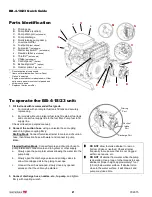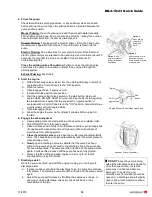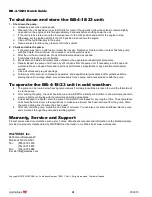
BB-4-18/23 Quick Guide
2
01/2015
Parts Identification
A. Priming cap
B. Pump intake (suction)
C. Pump drain port
(not shown)
D. Pump discharge
E. Quick release pump clamp
F. Low-tone muffler
G. Fuel pump
(not shown)
H. Fuel valve*
(not shown)
I.
Starter key switch**
(not shown)
J. Rewind starter
(not shown)
K. Throttle**
(not shown)
L. Choke
(not shown)
M. Control panel*
†
(option)
N. Exhaust primer*
‡
(option)
O. Guzzler primer
* (option)
* Denotes optional components
** Items not available when Control Panel
Option is selected
†
Engine mounted control panel shown. Other
options are panel mount control panels and
skid mount panels.
‡
Replaces low-tone muffler
A
B
D
F
G
H
I
J
K
L
N
O
M
C
E
To operate the BB-4-18/23 unit:
1. Fill fuel tank with recommended fuel grade.
a.
For models with an integral fuel tank, fill tank and securely
replace cap.
b.
For models without an integral fuel tank, fill external fuel tank
and connect fuel supply line to the fuel filter. Pump fuel to fill
supply line.
Check oil level (see engine manual).
Priming
Port
Suction/
Intake
Port
Discharge Port
2. Connect the suction hose
, using a universal hose coupling
wrench to tighten coupling firmly:
Drafting Mode
: Connect footvalve strainer to male end of suction
hose, then fill suction hose with water and connect to pump
intake.
Flooded Suction Mode
: Connect female end of suction hose to
pump intake and connect male end to hydrant or other supply.
a.
Slowly open the pump inlet valves allowing the water into the
pump body.
b.
Slowly open the discharge valves and priming valves to
allow for entrapped air in the piping to escape.
c.
Once all the air has escaped, slowly close any opened
valves so that the unit may be started.
!
DO NOT
allow footvalve strainer to rest on
bottom of lake or riverbed. Check strainer
frequently to make sure that it is not clogged
with moss, leaves, etc.
!
DO NOT
lift strainer from water while the pump
is operating. Use a rope or other means to keep
strainer at proper height, approximately 1 foot
(30 cm) below water surface. If strainer is too
close to the water surface, it will draw air and
pump may lose prime.
3. Connect discharge hose, nozzles, etc., to pump
, and tighten
firmly with coupling wrench.






















